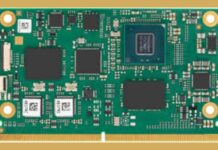Following the success of the de next form factor, which included the world’s smallest single board computers to host Intel Core and AMD Ryzen V2000 Series processors, AAEON has announced de next brand’s first edge system, the de next-TGU8-EZBOX.
Mirroring its record-breaking SBC counterparts, the de next-TGU8-EZBOX is the world’s smallest edge PC with an embedded Intel Core processor, measuring just 95.5mm x 69.5mm x 42.5mm with a heatsink, and 95.5mm x 69.5mm x 45.4mm with an active cooler. The system is suitable for edge computing and IoT gateway solutions, especially in scenarios with there is limited space. Furthermore, the benefits that come with fanless heat dissipation, such as low noise and protection against dust, will appeal to customers in both the digital signage and industrial markets.
The system retains many of the I/O features of its board counterparts, including multiple high-speed interfaces for industrial-grade performance. Two LAN ports, operating at both 2.5GbE and GbE speeds, are conveniently grouped together with two USB 3.2 Gen 2 ports and one HDMI 1.4b port for easy interface access during operation.
Offering high bandwidth and efficient data processing is 16GB of onboard LPDDR4x system memory. Additionally, the de next-TGU8-EZBOX provides expansion options through an M.2 2280 M-Key, capable of meeting application storage requirements. The de next-TGU8-EZBOX offers broad compatibility with operating systems, including Windows 10 and Ubuntu 20.04.4 (Kernel 5.13), for easy integration into existing IT infrastructures and development environments.
Since the release of the first de next-TGU8 board, the product line has expanded to include a full ecosystem encompassing single boards, dedicated expansion modules, and now a system-level solution.
While the de next-TGU8-EZBOX’s incredibly small size does not allow for the range of expansion offered by larger Mini PCs, AAEON notes that this is made up by the expansion module catalog compatible with both the de next-TGU8 and de next-V2K8 single-boards. For example, the PER-T642 grants users support for either AI acceleration or Wi-Fi modules when used in conjunction with the de next board series. Meanwhile, the PER-T643 pairs AI acceleration with 4G support. For industrial control tasks, the PER-R41P offers PCIe expansion along with a Riser Kit to enable additional interfaces such as storage, graphic capture cards, and Ethernet.

















